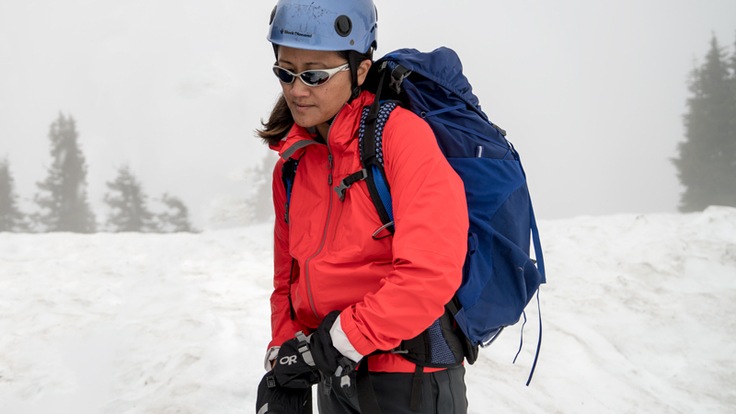On a climb to reach the summit of a peak you can experience a wide range of terrain and weather conditions. Where you might start out on a well-maintained trail in hot weather, higher elevations can include off-trail travel on snow or glaciers with high winds and frigid temps.
To stay comfortable while mountaineering, you need to dress in layers, just as you do when backpacking. With layers, you can adjust your comfort level by putting on and removing items as conditions or your exertion level changes. If you start to work up a sweat, you can stop and remove a jacket. If you feel chilled, you can put it back on. (To learn more about the fundamentals of layering, read our article, Layering Basics.)
Exactly what layers you choose to wear and pack for a mountaineering trip will depend on trip specifics like where you're going, what time of year it is and what conditions you're likely to encounter. This article will help you understand the basics of dressing for mountaineering by discussing common options for base layers, mid layers, insulation layers, outer layers and accessories. As you read on and make decisions about what to wear, here are some things to keep in mind:
- Weather can change quickly: Be sure to consider the full range of temperatures and weather you may encounter. Conditions can be dramatically different as you go from hiking below tree line to crossing a glacier to reach the summit.
- Weight vs. comfort: You don't want to overload your pack with lots of extra clothing, but you want to be comfortable. Think realistically about what you need to be comfortable during your climb. There will always be tradeoffs that can make deciding difficult. For instance, a super-insulated jacket will be heavier and bulkier than a trimmer one, but also warmer.
- Functionality: Outdoor clothing can be loaded with features, from pockets, vents and hoods to things like sun protection, insect repellent and antimicrobial treatments to reduce odors. As you consider clothing options, think about what's important to you and what features will enhance the performance of the pieces you choose. Try to avoid unnecessary features that only add weight and cost.
- Fabrics: Cotton takes a very long time to dry and is a poor insulator, so it should always be avoided on mountaineering climbs. Choose wool or synthetic options, like polyester or nylon, instead.
Base Layers for Mountaineering
Your next-to-skin clothing items are important because they help keep your skin dry by wicking moisture, so you stay warm and comfortable. Fabrics such as polyester or merino wool are both good choices.
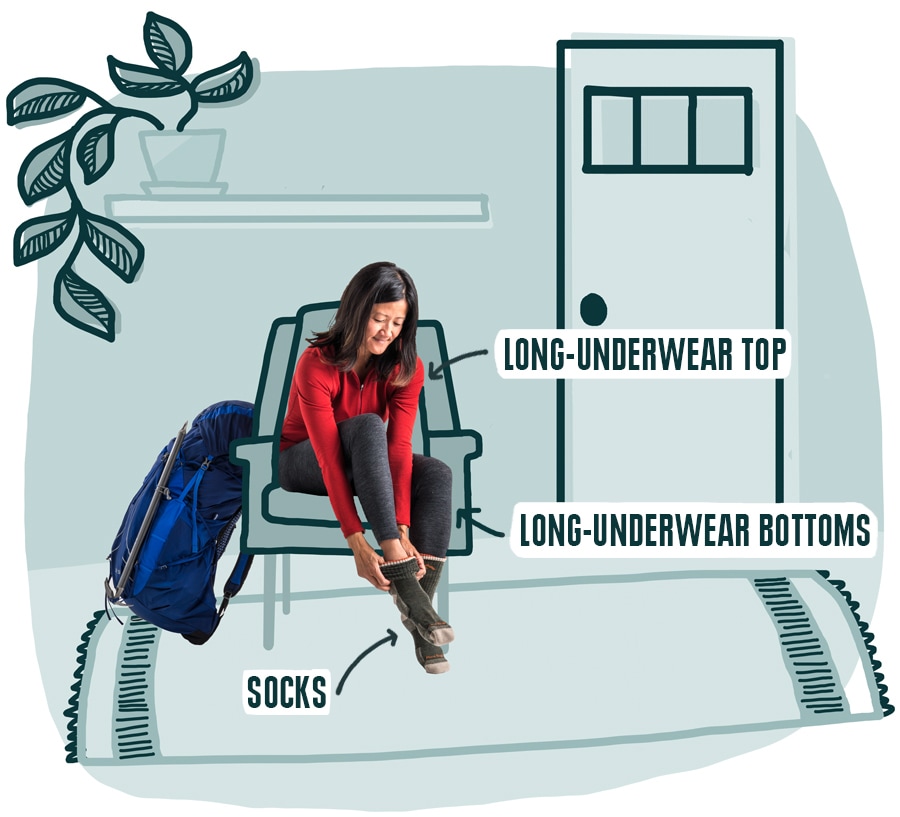
Underwear: What style underwear you choose is a matter of preference. In general, you'll want underwear that's airy and breathable and that is made from wool or a synthetic.
Bras: A pullover sports bra without any clasps is typically most comfortable. The metal or plastic parts on other styles of bras can dig into your skin when you're carrying a heavy pack.
T-shirt: A lightweight synthetic or wool T-shirt can be a nice layer to have for a warm approach hike, though some climbers will forgo it and wear their long-underwear top instead to save weight. You can choose short sleeves for better venting or long sleeves for more coverage from the sun.
Long-underwear top: For many climbers, a long-underwear top will be worn for the entire outing, including the approach hike and the summit climb, so it's important to pick one that works well for you. A top with a zip-neck is nice for venting during warm days lower on the mountain. A lightweight or midweight wool or synthetic top is usually the right choice, depending on the temperatures you anticipate and your personal preference. Wearing one that offers UPF sun protection is a good idea.
Long-underwear bottoms: These are a must for mountaineering climbs. You'll probably keep them in your pack during a warm approach hike, but when you're cooling off at camp or getting ready for your summit climb, they will be worn underneath your climbing pants. They're nice for sleeping in, too. Lightweight or midweight long-underwear bottoms made from wool or a synthetic material are a good option. For early- or late-season climbs where you know you will experience really cold temperatures, you could opt for heavyweight long-underwear bottoms.
Socks: Quality socks are very important for keeping your feet warm, dry and comfortable on a long climb. Choose either wool or synthetic, never cotton. The length of trip and your personal preference will determine how many pairs to bring, but for a trip lasting a few days, two pairs of socks are typically enough. You may choose a lighter weight pair for warmer temps lower on the mountain and a midweight or heavyweight pair for higher up.
Mid Layers for Mountaineering
Worn over your base layers, mid layers provide warmth, abrasion resistance, water resistance and wind resistance. There are lots of options for mid layers, but some of the classic choices for mountaineering include fleece jackets, soft-shell jackets and soft-shell climbing pants.
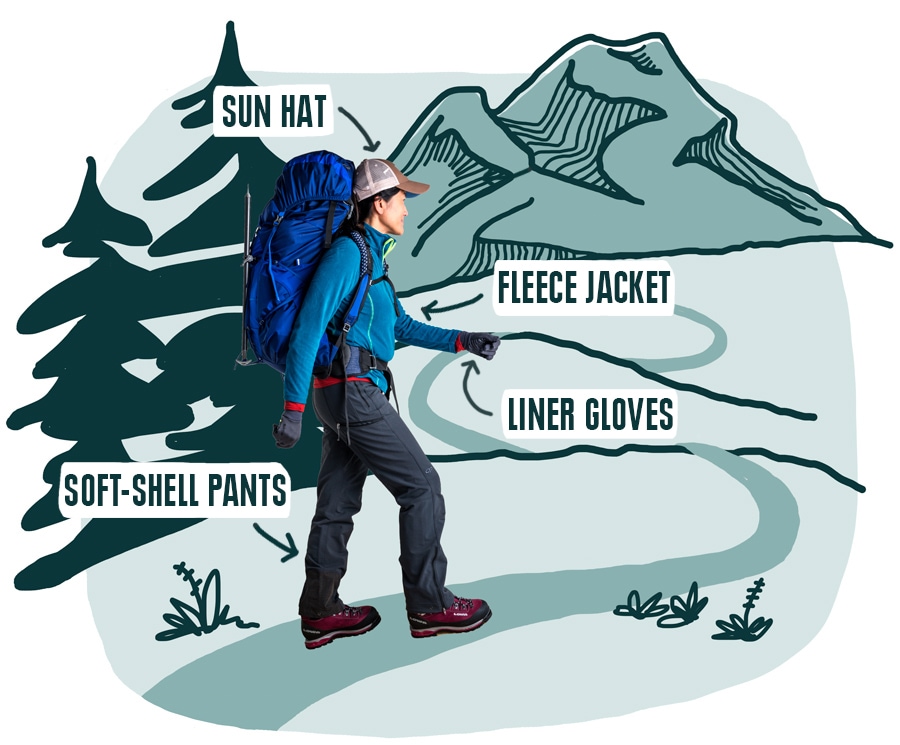
Fleece jacket: A lightweight fleece jacket is a nice piece to pull on over your long-underwear top when you stop for a break during your approach hike. You'll likely also wear it during an early morning start on your summit day.
Soft-shell jacket: This piece is somewhat interchangeable with a fleece jacket, so you may opt for one or the other, but you could carry both if the conditions warrant it. The benefits of a soft-shell jacket include better wind and water resistance compared with a fleece and better breathability compared with a fully waterproof rain jacket. A helmet-compatible hood is a good feature to look for.
Soft-shell climbing pants: A quality pair of soft-shell climbing pants are a core item that every mountaineer should have; you'll wear them from the parking lot to the top of the mountain and all the way back down. Soft-shell climbing pants are more durable than hiking pants and they do a better job of blocking wind and rain. Their stretchy fabric gives you the range of motion you need for climbing mountains. On a warm approach hike, you'll wear soft-shell pants over just your underwear. Higher on the mountain, when it cools off, you can layer them over long underwear and/or under rain pants.
Sun hat: A wide-brimmed hat or baseball cap is essential for shade when you're hiking under intense sun. Some hats have a sun cape on the back to cover your neck.
Liner gloves: Lightweight liner gloves are nice to have when you're lower down on the mountain where the temps aren't too cold but you still want a little warmth and some protection against the snow if you slip and have to put a hand down. Liner gloves also provide sun protection.
Insulation Layers for Mountaineering
Just how much insulation you need depends a lot on where you're going and what time of year it is. For climbs that take you onto mountains where cold temperatures are the norm, you'll want a fairly substantial insulated jacket, and you'll likely also need insulated pants. A lighter jacket and no insulated pants may be fine for lower peaks or mountains in locations where extreme cold is not a risk.
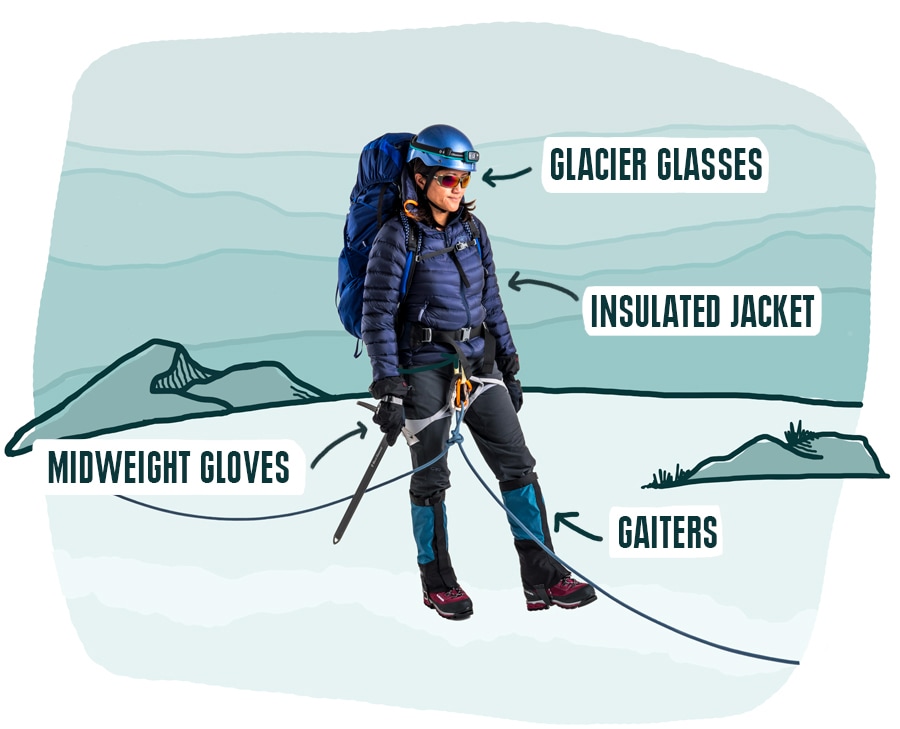
Insulated jacket: An insulated jacket with a hood is a must for staying warm in the mountains. Keep this layer near the top of your pack while climbing so you can quickly pull it on over everything else you're wearing when you stop for a break. The type of insulation and how much of it you need depend on several factors, including your budget, the climate and how packable you need to the piece to be. Down provides the most warmth for the least bulk and weight, but it won't insulate well when it's wet (though many jackets are now made with water-resistant down, which helps improve performance). Synthetic insulation is bulkier and heavier, but more cost effective and a better insulator in damp conditions. Learn more in our article, How to Choose Insulated Outwear.
Insulated pants: These are optional depending on the time of year and location of your climb. For warm-weather ascents, you may be fine without them. But for climbs on big peaks or early- or late-season ascents of smaller mountains, a warm pair of insulated pants will be nice to pull on when you're high on the route or resting at camp. Look for pants with full-length side zippers so you can get the pants on while wearing boots and crampons. As with jackets, you have a choice between down and synthetic insulation. Learn more in our article, How to Choose Insulated Outwear.
Winter hat: Bring a low-profile winter hat that will fit underneath your climbing helmet.
Glacier glasses: Your everyday sunglasses may not cut it on the mountain. Glacier glasses are designed specifically to protect your eyes from the intense light at high altitudes and sunlight reflecting off snow. They often feature wrap-around extensions to block light from entering at the sides. Most glacier glasses have a visible light transmission (the amount of light that reaches your eyes through the lenses) of 5%-19%, whereas everyday sunglasses are often in the range of 20%-40%. Learn more about sunglasses in our Sunglasses: How to Choose article.
Midweight gloves: As you get higher on the mountain, your liner gloves may not provide enough warmth. A pair of midweight gloves should provide ample warmth for cold weather while still providing enough dexterity to handle ropes, hold an ice axe and operate zippers.
Gaiters: Gaiters not only keep snow and rain from getting into your boots, but they also do a good job of containing your baggy pant cuffs, making it less likely that you'll snag a crampon and rip your pants. Get a tall pair that come up to just below your knees and have reinforcements at the insteps.
Outer Layers (Rain Jacket and Pants) for Mountaineering
Your outer layers are your waterproof layers. These may stay in your pack for most of the trip, so long as the weather is dry. That said, a waterproof jacket and pants provide great protection against wind, so don't hesitate to put them on even if it's not raining or snowing.
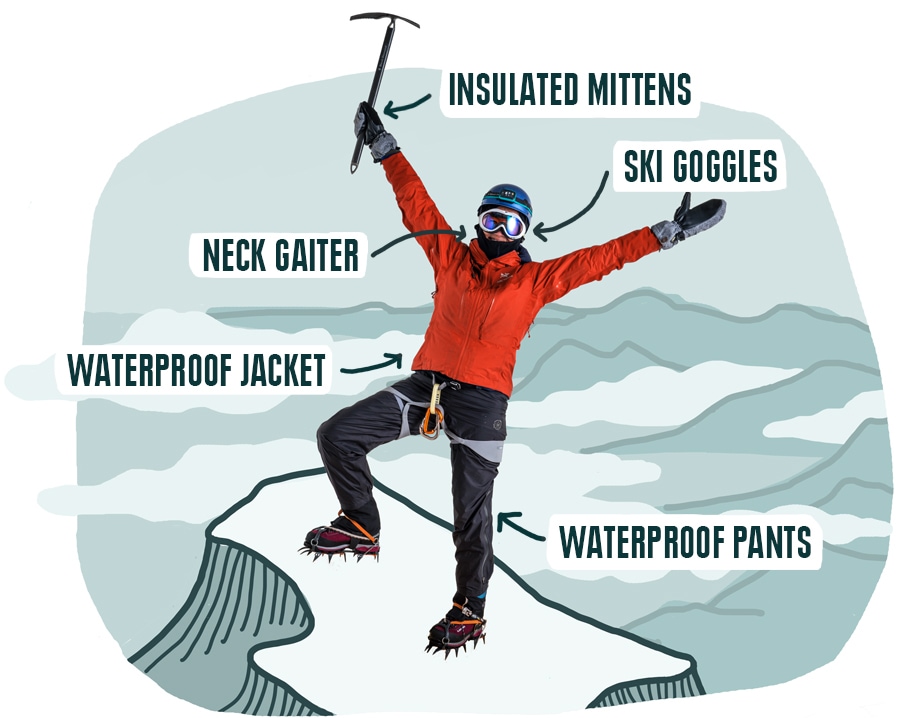
Waterproof jacket: Look for a straightforward waterproof/breathable shell jacket that keeps you reliably dry. Also, make sure the hood is designed to fit over a climbing helmet. It's nice if the pockets are positioned such that you can get in and out of them while wearing your backpack.
Waterproof pants: Lightweight waterproof shell pants are crucial for keeping your other layers dry if it starts to rain or snow. You'll probably also want to pull them on during long sections of glissading. As with the insulated pants, it's essential that these pants have full-length side zippers that will allow you to get the pants on with your boots and crampons on.
Ski goggles: If you anticipate really cold temperatures and high winds, then bring along a pair of ski goggles in addition to your glacier glasses. They will be warmer and do a better job of keeping wind out.
Neck gaiter or balaclava: When the wind picks up and the temperature drops, pull on a neck gaiter or balaclava to keep your face warm. A neck gaiter that can be worn multiple ways is especially versatile for mountaineering—this single clothing item can serve as a hat, ear band or face mask.
Insulated mittens: A warm pair of insulated mittens are ideal for when you're high on the mountain in really cold weather. They'll cut down on your dexterity, but they'll keep your fingers toasty. They might stay in your pack most of the time, but you'll be happy to have them when you need them.
